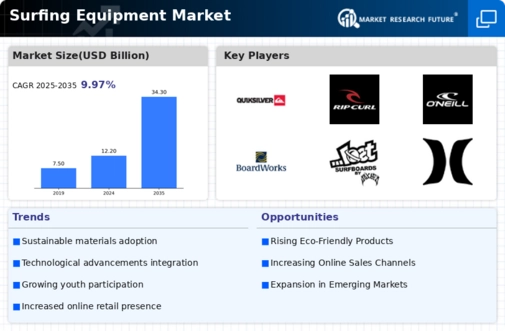Rising Popularity of Surfing
The Global Surfing Equipment Market Industry experiences a notable surge in popularity, driven by an increasing number of individuals engaging in surfing as a recreational activity. This trend is particularly evident among younger demographics, who are drawn to the sport's adventurous nature and lifestyle appeal. As of 2024, the market is valued at approximately 12.2 USD Billion, reflecting a growing consumer base. The rise of social media platforms showcasing surfing experiences further fuels this interest, encouraging participation and driving demand for surfing equipment. This burgeoning popularity suggests a robust growth trajectory for the industry in the coming years.
Emerging Markets and Global Expansion
Emerging markets present substantial opportunities for the Global Surfing Equipment Market Industry. Regions such as Asia-Pacific and Latin America are experiencing a rise in surfing popularity, driven by improved access to coastal areas and increased disposable income. As these markets develop, the demand for surfing equipment is likely to grow, supported by local surf schools and rental services. The industry's expansion into these regions could lead to a compound annual growth rate of 9.86% from 2025 to 2035, reflecting the potential for significant market growth. Companies that strategically enter these emerging markets may capitalize on this upward trend.
Market Trends and Consumer Preferences
The Global Surfing Equipment Market Industry is influenced by evolving consumer preferences and market trends. As surfers seek personalized and high-quality products, brands are adapting their offerings to meet these demands. Trends such as custom surfboard designs and tailored wetsuits are gaining traction, allowing consumers to express their individuality while enhancing performance. Additionally, the rise of online retail platforms facilitates access to a wider range of products, catering to diverse consumer needs. This shift in purchasing behavior indicates a dynamic market landscape, where brands must remain agile to respond to changing consumer expectations and preferences.
Technological Advancements in Equipment
Technological innovations play a crucial role in shaping the Global Surfing Equipment Market Industry. Manufacturers are increasingly investing in research and development to create high-performance surfboards, wetsuits, and accessories that enhance the surfing experience. For instance, advancements in materials such as lightweight composites and hydrodynamic designs improve maneuverability and speed. These innovations not only cater to professional surfers but also attract beginners seeking quality equipment. As the industry evolves, the integration of smart technologies, such as wearable devices that track performance metrics, could further enhance user engagement and satisfaction, driving market growth.
Growth of Surfing Events and Competitions
The proliferation of surfing events and competitions significantly contributes to the expansion of the Global Surfing Equipment Market Industry. Major events, such as the World Surf League competitions, attract global audiences and inspire increased participation in the sport. These events not only showcase elite talent but also promote surfing culture, leading to heightened interest among spectators and potential surfers. The growing number of local and international competitions encourages investment in high-quality equipment, as participants seek to enhance their performance. This trend indicates a promising outlook for the industry, with projections suggesting a market value of 34.3 USD Billion by 2035.
Environmental Awareness and Sustainability
The Global Surfing Equipment Market Industry is witnessing a shift towards sustainability, as consumers become more environmentally conscious. Brands are increasingly adopting eco-friendly practices, such as using recycled materials in the production of surfboards and wetsuits. This trend aligns with the broader movement towards sustainable consumerism, where individuals prioritize products that minimize environmental impact. Companies that embrace sustainable practices may gain a competitive edge, appealing to a growing segment of eco-conscious surfers. As awareness of climate change and ocean conservation rises, the demand for sustainable surfing equipment is likely to increase, influencing market dynamics.














